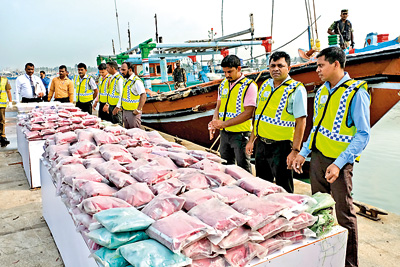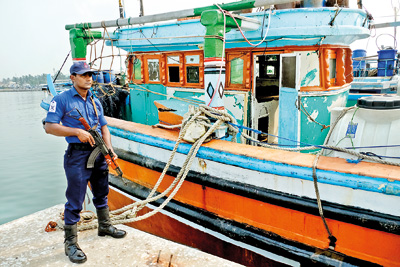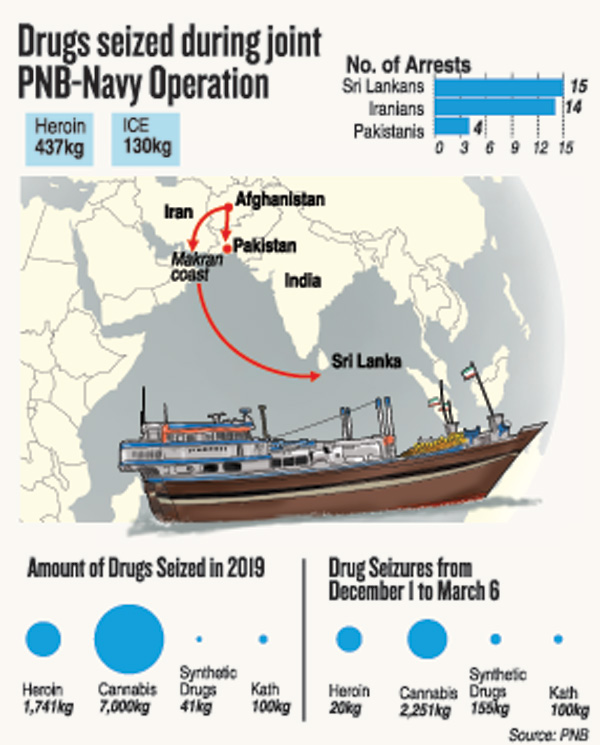News
Sri Lankan drug lord linked to Iranian and Pakistani heroin smugglers
A Sri Lankan mastermind overseas is being sought for the narcotics smuggling network that was uncovered this week following a month-long joint operation by the Police Narcotics Bureau (PNB) and the Sri Lanka Navy.

A total of 437 kilograms of heroin and about 130 kilograms of methamphetamine, or ‘ice’, were seized
As of Friday, 33 suspects including 14 Iranians, four Pakistanis and 15 Sri Lankans were being held for questioning.
The police are hunting two other Sri Lankans, while international assistance is being sought to trace the mastermind.
The operation was undertaken following information received by the PNB, which sought assistance from the navy to track down vessels that were hauling the drugs to the southern coast.
Offshore patrol vessels, Samudura and Sindurala, with several PNB officers on board, spent a month at sea and cornered two foreign trawlers that were not flying the flag of any country and a local fishing boat that had loaded the drugs from those vessels to be brought to shore.
A total of 437 kilograms of heroin and about 130 kilograms of methamphetamine, or ‘ice’, were seized.
The patrol ships operated as far as 6,000 nautical miles (1111 kilometres) off the Sri Lankan coast. This is the biggest drug bust so far by the Sri Lankan agencies in the high seas.
Meanwhile, drug peddlers who were waiting on the beach at Kudawella in Dikwella, Matara to take possession of the narcotics were taken into PNB custody as well.
The drug-laden vessels were escorted to the Dikowita Fisheries Harbour by the navy on Thursday.
Authorities have hailed the detection as a success in a coordinated operation.
The foreign vessels are believed to have originated from the Iran-Pakistan coast.
The heroin, which is smuggled from Afghanistan, is usually transported to countries such as Sri Lanka via sea from either Iran or Pakistan, according to PNB Director Senior Superintendent of Police (SSP) Manjula Senarath.
The foreign vessels are met by local fishing trawlers, either in international waters, or even inside the country’s territorial waters, where a mid-sea transfer takes place. The drugs are then unloaded to small dinghies, which then bring them ashore to a designated point, where they are picked up by yet another team to be transported to hideouts, he explained.
While the haul is valued at over Rs 6 billion, the PNB director said it’s not the monetary value that really matters.

One of the drug-laden vessels that were escorted to the Dikowita Fisheries Harbour by the navy on Thursday. Pix by Amila Gamage
“According to the latest report from the Government Analyst, their purity levels were only between 2-12%. This means that the heroin was diluted with various chemicals and distributed to increase volume. The 400 kilos of heroin we seized have a purity level of 80%. We know this because a special seal on the packaging indicates its purity level for traffickers. If this consignment of heroin had been diluted to the level of the drugs being sold at street level now, it means they could have been able to make anywhere between 4,000 to 5,000 kilos of heroin from this stock alone. You can imagine how much damage it would have caused if such a vast amount of drugs found their way into the market.”
Three networks are involved in trafficking narcotics into Sri Lanka — international, Asian, and the local network.
Those hauling the drugs to shore from the high seas are usually fishermen, some of whom are drug addicts themselves.
“The drug kingpins recruit fishermen as couriers. They are at the bottom of the network, paid a small amount, but for them, it is sizeable. They are given a satellite phone and a handler sends GPS coordinates to them to rendezvous with the foreign vessel, which is also sent the same coordinates. Once the transfer happens, those from the smaller boats assigned to bring the drugs ashore are also sent GPS coordinates assigning them a point to pick up the drugs and another set of coordinates on where to bring them ashore. The team on the ground is then given the coordinates to pick them up,” SSP Senarath said.
According to the PNB, the strength of the network is that one group has no idea about the other. Only the handler knows all of them. This means that if police were to arrest a man who came to retrieve the drugs on shore, he would know nothing about those who brought them ashore on the boat. This is very similar to the style adopted by the LTTE’s suicide bomber networks during the war, making them extremely hard to dismantle. “They are very smart, so we have to be smarter,” SSP Senarath stressed.
The PNB and the navy analysed a large number of phone records and used various other methods to track down the ‘dhow’ transporting the drugs.
“I believe they were surprised at the way we managed to capture all of them,” the PNB director quipped.
Most international drug traffickers linked to Sri Lanka are known to operate from Dubai and Pakistan.
There are also several leading drug traffickers in the country and may operate from prisons.
At a media briefing on Thursday, the Director (Legal Division) of the Sri Lanka Police Deputy Inspector General (DIG) Ajith Rohana, said while more than 95% of prison officers could be deemed to be honest, a few corrupt jailers are conduits for mobile phones and SIM cards that are smuggled into the hands of convicts involved in drug trafficking and other crimes.
“We are constantly in touch with the Prisons Department. They have agreed on the need to constantly search inmates whom we have identified as being linked to drug trafficking. If necessary, they should be sent to prisons such as Angunakolapelessa where there is a Special Task Force detachment,” he said. 
SSP Senarath, meanwhile, said it was frustrating that drug traffickers, some of whom were on death row, or were serving life sentences for drug trafficking, were continuing to run such operations from prison.
“Installing jammers to block mobile phone reception is not practical as prisons such Welikada are located in densely populated areas. The jammers will also prevent those outside the prison from using mobile phones. The best solution would be to move such prisons to less populated areas so using jammers can be explored.”
Another major headache for law enforcement agencies is the sheer number of unregistered fishing boats. During the war, all boats set sail from a designated area under a marshaling system, making them easy to track, according to authorities. This is not the case post-war. While multi-day fishing trawlers are registered and must leave and return to a fisheries harbour, many smaller vessels can put out to sea from anywhere. Drug traffickers have recruited a significant number of fishermen as couriers to bring the drugs ashore. The lack of registration makes it extremely difficult to track the small vessels.
“We have held numerous discussions with the Fisheries Department to find a solution, since the lack of unregistered boats is a serious issue,” SSP Senarath said.
Cannabis remains the most widely-trafficked narcotic, with “Kerala ganja” from India being the more popular among traffickers owing to its high street value.
Law enforcement agencies have also made large detections of synthetic drugs including methamphetamines, ecstasy and LSD, and “kath,” a narcotic smuggled in air mail parcels from Africa. They say that kath, mainly smuggled countries such as Ethiopia and Ghana, are being mixed with tea leaves and being re-exported as herbal tea.
In the past three months from December 1 to March 6, the PNB says they and the police have seized over 920kg of heroin, 2251kg of cannabis, 155kg of synthetic drugs and 100kg of kath.
The large stocks of synthetic drugs seized reflect the demand among youth, authorities say. The drugs are distributed in various forms, such as pills (ecstasy) or stamps and tattoos (LSD).
Reducing supply through operations is only a part of the overall strategy. The efforts will not succeed without reducing demand by ensuring people don’t fall prey to drugs and also by rehabilitating addicts. Awareness programmes have been carried out involving more than 200,000 school students as well as teachers last year. These programmes will continue. Awareness is being raised through some 14,000 civil defence committees.
Authorities are also urging parents to nurture close bonds with children because drug dealers continue to target students. The Sunday Times last week reported that investigations have begun into an alleged operation at a school in Peradeniya where senior students were distributing narcotics-laced toffees in grades six, seven, and eight to encourage dependency. The toffees had apparently been given to senior students by several outsiders.
DIG Ajith Rohana, told journalists on Thursday that police will start an anti-narcotics drive in schools, through community police. Undercover police will also operate near schools where drug dealers are operating, especially in the Western Province and Kandy District.

